Standing up for tradeswomen
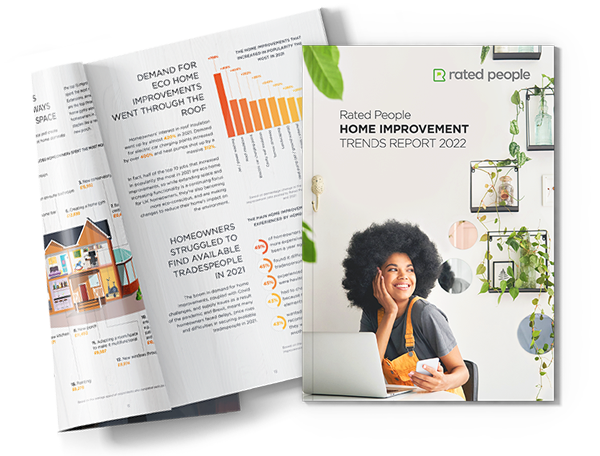 For insights on the biggest trends in renovation and home improvement, take a look at the Rated People Home Improvement Trends Report 2022 |
So much has been done in recent years to promote diversity and end inequality – there’s still a long way to go, but there are positive signs that change is starting to happen.
Watch our video with four truly inspirational tradeswomen
International Women’s Day: 8th March 2022
International Women’s Day is an annual international initiative, striving for a gender equal world and helping to raise awareness of inequality while empowering women to succeed. The theme of IWD 2022 is #BreakTheBias. That’s exactly the objective of one of our Home Improvement Trends Report features, asking: “Why aren’t there more tradeswomen in the UK?”, and the reason we created The Rated People Empowering Tradeswomen Programme.
The Rated People Empowering Tradeswomen Programme helps women get into the trades industry and build successful careers. Read more now
When it comes to women in the trades industry, inclusive of all who identify as women – did you know just how imbalanced it is? Women make up less than 1% of carpenters and less than 2% of electricians and plumbers are women. And of the 20 worst professions in the UK for the representation of women, more than half are trade jobs.
This isn’t right.
To discover the reasons behind the shockingly low representation of women in the trades industry, we spoke to school leavers about the careers advice they were given in school. We also listened to more than 600 tradespeople across the UK. And we also spoke to thousands of homeowners about their attitudes to hiring tradeswomen.
Some of the things we found out were shocking, and others encouraging. But one thing was clear, we wanted to do something about it to make it easier for more women to get into the industry and thrive in their trade careers.
Because it’s 2022, and it’s about time this changed.

The worst jobs in the UK right now for the representation of women
Just 0.81% of vehicle technicians are women, which is the lowest of more than 300 professions in the UK.
Carpenters and joiners are second-worst for the representation of women, with below 1% (0.99%) of the employees being women, followed by electricians where just 1.73% of the workforce is made up of women.
Across the 20 professions with the lowest representation of women, none of them have more than 5% of women in the workforce. And within those 20, 11 of them are in the trades industry.
20 worst jobs for the representation of women
| Occupation | Women in workforce 2021 | Men in workforce 2021 | |
| 1 | Vehicle technicians, mechanics and electricians | 1,600 (0.81%) | 195,672 (99.19%) |
| 2 | Carpenters and joiners | 2,399 (0.99%) | 240,302 (99.01%) |
| 3 | Electricians and electrical fitters | 4,177 (1.73%) | 236,820 (98.27%) |
| 4 | Plumbers and heating and ventilating engineers | 3,283 (1.93%) | 166,669 (98.07%) |
| 5 | Metal working production and maintenance fitters | 3,594 (1.93%) | 182,955 (98.07%) |
| 6 | Mobile machine drivers and operatives | 1,240 (2.1%) | 57,821 (97.9%) |
| 7 | Large goods vehicle drivers | 8,571 (2.57%) | 324,693 (97.43%) |
| 8 | Fork-lift truck drivers | 2,978 (2.61%) | 110,925 (97.39%) |
| 9 | Elementary construction occupations | 5,383 (3.03%) | 172,516 (96.97%) |
| 10 | Glaziers, window fabricators and fitters | 1,472 (3.45%) | 41,151 (96.55%) |
| 11 | Floorers and wall tilers | 1,111 (3.46%) | 30,990 (96.54%) |
| 12 | Electrical and electronics technicians | 1,177 (3.61%) | 31,467 (96.39%) |
| 13 | Electrical and electronic trades | 2,932 (3.91%) | 72,107 (96.09%) |
| 14 | Construction and building trades | 9,829 (4.01%) | 235,280 (95.99%) |
| 15 | Paper and wood machine operatives | 1,080 (4.11%) | 25,179 (95.89%) |
| 16 | Design and development engineers | 3,357 (4.16%) | 77,380 (95.84%) |
| 17 | Taxi and cab drivers and chauffeurs | 10,746 (4.54%) | 225,770 (95.46%) |
| 18 | Telecommunications engineers | 2,592 (4.7%) | 52,575 (95.3%) |
| 19 | Skilled metal, electrical and electronic trades supervisors | 1,920 (4.75%) | 38,507 (95.25%) |
| 20 | Painters and decorators | 6,211 (4.92%) | 120,091 (95.08%) |

The top 20 jobs with the highest representation of women right now
Looking at the professions where women make up the majority of the workforce, many of the roles in the top 20 are in childcare. These include nursery nurses in first place, where women make up 98% of the UK workforce, childminders are in fourth position, school secretaries are sixth and teaching assistants are in seventh. None of the professions in the top 20 are in the trades industry.
Although it is great to see industries where women continue to be the trailblazers, this is more proof that attitudes towards what’s considered a ‘woman’s job’ or a ‘man’s job’ needs to change.
Just as the trade industry needs more opportunities for women to feel comfortable and excel, there also needs to be more men entering caring and teaching roles to show future generations that women can fit your kitchen or fix your heating just as men can teach, nurture and entertain nursery children.
20 best jobs for the representation of women
| Occupation | Women in workforce 2021 | Men in workforce 2021 | |
| 1 | Nursery nurses and assistants | 215,561 (97.77%) | 4,912 (2.23%) |
| 2 | Legal secretaries | 35,032 (96.04%) | 1,446 (3.96%) |
| 3 | Medical secretaries | 56,579 (95.25%) | 2,822 (4.75%) |
| 4 | Childminders and related occupations | 150,240 (94.98%) | 7,940 (5.02%) |
| 5 | Personal assistants and other secretaries | 173,686 (94.87%) | 9,387 (5.13%) |
| 6 | School secretaries | 50,358 (91.08%) | 4,933 (8.92%) |
| 7 | Teaching assistants | 398,107 (90.68%) | 40,930 (9.32%) |
| 8 | Therapy professionals | 43,760 (89.62%) | 5,066 (10.38%) |
| 9 | Housekeepers and related occupations | 41,708 (89.55%) | 4,865 (10.45%) |
| 10 | Dancers and choreographers | 16,742 (89.3%) | 2,007 (10.7%) |
| 11 | Receptionists | 172,480 (89.21%) | 20,852 (10.79%) |
| 12 | Pharmacy and other dispensing assistants | 76,166 (88.81%) | 9,595 (11.19%) |
| 13 | Educational support assistants | 147,627 (88.68%) | 18,852 (11.32%) |
| 14 | Psychologists | 42,091 (87.74%) | 5,884 (12.26%) |
| 15 | School midday and crossing patrol occupations | 105,464 (87.01%) | 15,742 (12.99%) |
| 16 | Primary and nursery education teaching professionals | 430,707 (86.45%) | 67,487 (13.55%) |
| 17 | Pharmaceutical technicians | 30,703 (86.43%) | 4,822 (13.57%) |
| 18 | Travel agents | 36,103 (85.8%) | 5,974 (14.2%) |
| 19 | Podiatrists | 16,646 (85.77%) | 2,761 (14.23%) |
| 20 | Beauticians and related occupations | 87,557 (84.87%) | 15,611 (15.13%) |
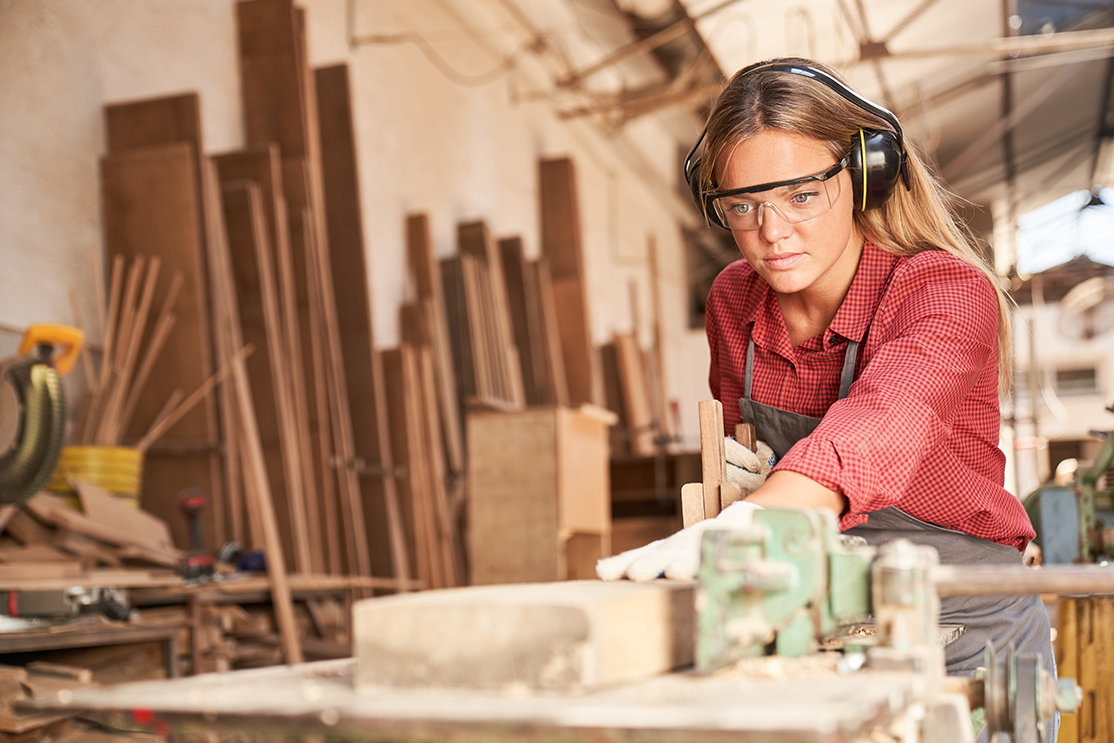
The representation of women in 15 key trades
Across 15 key trades in the industry, women only make up more of the workforce in one of the professions – cleaning. For all other 14 jobs in the trade industry, none of them have more than 10% of women in the workforce.
Less than 1% of carpenters are women, and less than 5% of plumbers, builders, electricians and painters in the UK are women.
| Rank | Trade | Women in workforce 2021 | Men in workforce 2021 |
| 1 | Carpenters and joiners | 2,399 (0.99%) | 240,302 (99.01%) |
| 2 | Electricians and electrical fitters | 4,177 (1.73%) | 236,820 (98.27%) |
| 3 | Plumbers and heating and ventilating engineers | 3,283 (1.93%) | 166,669 (98.07%) |
| 4 | Metal working production and maintenance fitters | 3,594 (1.93%) | 182,955 (98.07%) |
| 5 | Elementary construction occupations | 5,383 (3.03%) | 172,516 (96.97%) |
| 6 | Glaziers, window fabricators and fitters | 1,472 (3.45%) | 41,151 (96.55%) |
| 7 | Floorers and wall tilers | 1,111 (3.46%) | 30,990 (96.54%) |
| 8 | Electrical and electronics technicians | 1,177 (3.61%) | 31,467 (96.39%) |
| 9 | Electrical and electronic trades | 2,932 (3.91%) | 72,107 (96.09%) |
| 10 | Construction and building trades | 9,829 (4.01%) | 235,280 (95.99%) |
| 11 | Painters and decorators | 6,211 (4.92%) | 120,091 (95.08%) |
| 12 | Window cleaners | 3,741 (8.46%) | 40,460 (91.54%) |
| 13 | Gardeners and landscape gardeners | 14,121 (9.67%) | 131,851 (90.33%) |
| 14 | Groundsmen and greenkeepers | 2,489 (9.67%) | 23,238 (90.33%) |
| 15 | Cleaners and domestics | 584,571 (81.63%) | 131,557 (18.37%) |

Why are there so few women in the trades industry?
We spoke to three school leavers to see if they would consider working as a tradeswoman and we also asked them about the career advice they got at school.
Two of the three young women said that they wouldn’t consider being a tradeswoman because of how “male-orientated” the industry is, with one adding “being a woman going into that industry is quite daunting.”
Both also spoke about how the industry isn’t promoted to girls in school.
“In secondary school and college this option is never usually targeted towards women when it comes to apprenticeships – they are stereotypically centred around beauty and hair, giving the sense that this is a ‘woman’s job,’ and being in the trades industry is a ‘man’s job.’ Although, I disagree with that, the option to be in the trade industry definitely feels like it is shut off to women.”
One of the school leavers also followed up with concerns around personal safety. She said: “I don’t feel comfortable as a woman going into other people’s houses and I feel I would come under a lot of judgement.”
This, although a small sample, could indicate that one of the reasons why more women aren’t getting into trades is because of how opportunities are communicated to them.

The pay gap
On average, women earn just 72% of what men do across 15 key trades in the industry, which could be another reason for women not wanting to work in the industry.
On average women earn almost 30% less than men, but for women floorers and wall tilers, they earn 59% less than men in the same profession, making it the occupation with the largest gender pay gap in the trades industry.
Women metal workers earn just 51% of a man’s salary in the same trade, seeing a £18,772 difference in pay over a year. Glaziers and window fitters closely follow, as women earn just 52% of a man’s salary (or 48% less).
Women electricians earn 54% of what men do. Women in construction and building trades only earn the equivalent of 57% of a man’s salary, and women plumbers would take home just 61% of what a man would in the same trade.
10 trades with the biggest gender pay gaps
| Rank | Occupation | Average women’s annual pay | Average men’s annual pay | Difference in pay | Women’s pay as a percentage of men’s |
| 1 | Floorers and wall tilers | £12,514 | £30,764 | £18,250 | 41% |
| 2 | Metal working production and maintenance fitters | £19,814 | £38,586 | £18,772 | 51% |
| 3 | Electrical and electronic trades | £19,814 | £38,586 | £18,772 | 51% |
| 4 | Glaziers, window fabricators and fitters | £13,557 | £26,071 | £12,514 | 52% |
| 5 | Carpenters and joiners | £16,686 | £31,286 | £14,600 | 53% |
| 6 | Electricians and electrical fitters | £20,336 | £37,543 | £17,207 | 54% |
| 7 | Construction and building trades | £18,250 | £31,807 | £13,557 | 57% |
| 8 | Painters and decorators | £16,164 | £28,157 | £11,993 | 57% |
| 9 | Plumbers and heating and ventilating engineers | £21,900 | £35,979 | £14,079 | 61% |
| 10 | Electrical and electronics technicians | £26,593 | £33,371 | £6,778 | 80% |
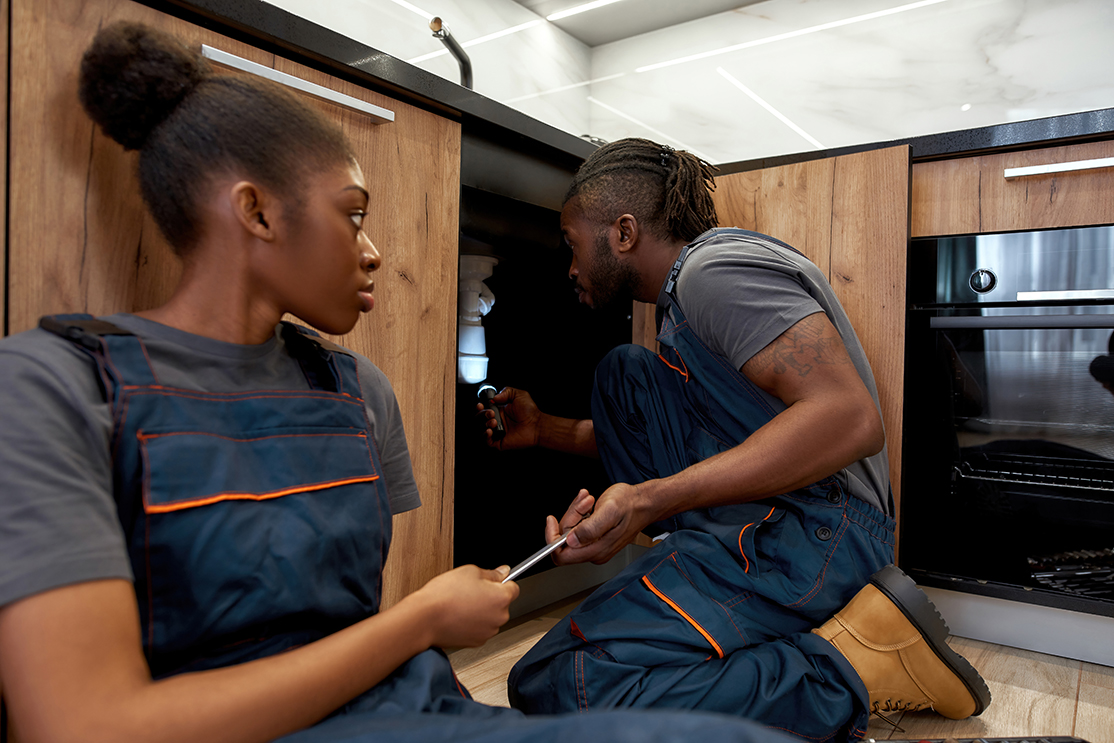
The biggest challenges for tradeswomen
More than one in three tradeswomen say they experience gender discrimination by customers, with 39% saying “some customers don’t take me seriously because of my gender”. And almost one in 10 said some of their customers have completely refused to let them do a job when they see they’re a woman.
One in seven (15%) say they have concerns for personal safety, almost 10% (9%) say they face social stigma and judgement from their friends and family, and almost one in 10 (9%) say sexism is the biggest challenge they face.
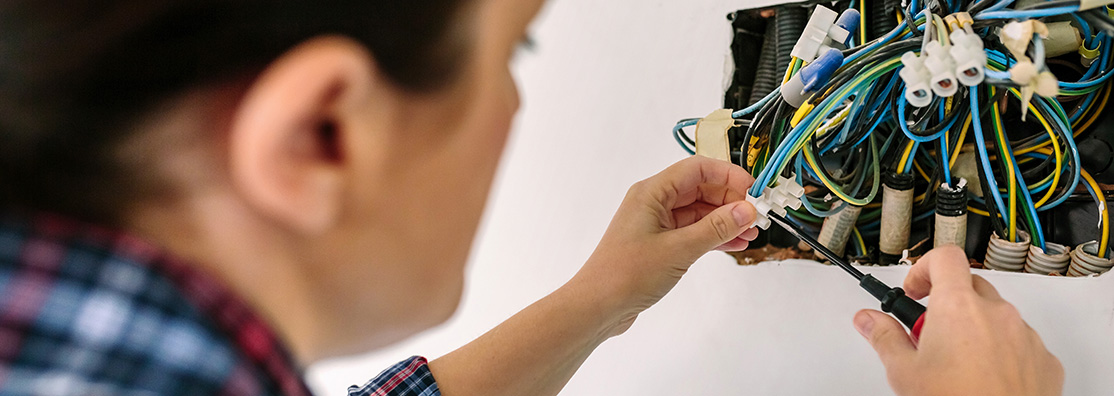
The benefits of working as a tradeswoman
We also asked tradeswomen what they most valued about working in the trades industry and this revealed flexibility and autonomy are some of the biggest benefits:
- 22% enjoy being their own boss
- 18% said flexible working hours was the key benefit for them
- 15% like being able to choose how much work to take on
- 12% said that they just love their job
- 8% said getting to help women who don’t feel comfortable having a tradesman in their home was rewarding for them
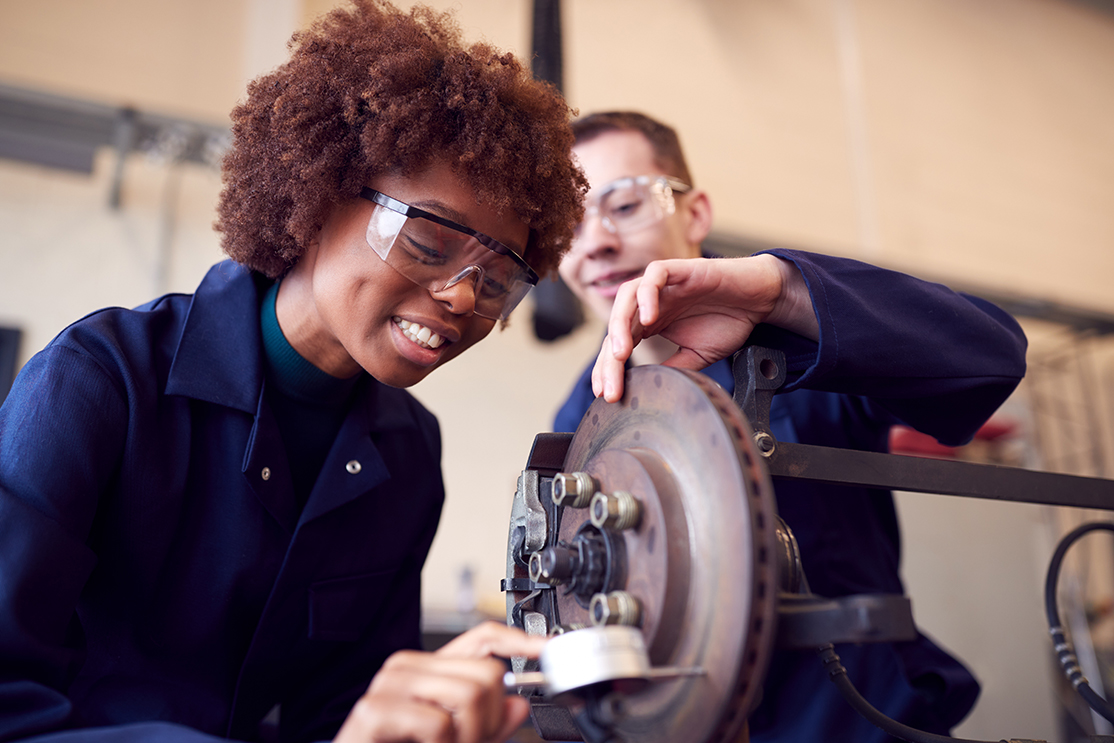
Opportunities for tradeswomen
Positively, there are some good indicators that things are starting to change in the industry. This could be a knock-on effect of so many people reevaluating their careers and jobs during the pandemic, but encouragingly, 32% of women across the UK say they’d now potentially consider changing career to work as a tradeswoman.
Access Training also revealed that the admissions of women on trade courses increased by 27% in 2021, suggesting the tide is starting to change.
Our research found that nearly half of UK homeowners (46%) say they would definitely hire a tradeswoman and 43% said that they would have no preference between hiring a tradesman or tradeswoman. Just 11% of UK homeowners said they would only look to hire a tradesman.
We also analysed Google search data to gauge homeowner demand for tradeswomen. UK homeowners looked online for women painters more than any other trade in 2021, pulling in 27,500 Google searches over a 12-month period, and women builders, gardeners, plumbers and electricians make up the rest of the top five most searched for types of tradeswomen.
| Female/Women + Trade | Annual Google Searches | |
| 1 | Painter | 27,500 |
| 2 | Builder | 9,290 |
| 3 | Gardener | 7,810 |
| 4 | Plumber | 7,030 |
| 5 | Electricians | 5,600 |

The Rated People Empowering Tradeswomen Programme
 For insights on the biggest trends in renovation and home improvement, take a look at the Rated People Home Improvement Trends Report 2022 |
Building on our research, we wanted to create an ‘Empowering Tradeswomen’ programme to help more women get into the trades industry and build successful careers. Whether that’s someone who’s considering a career change, or someone who’ll soon be leaving school, the programme is designed to help women at all stages of their trades careers.
It’s brilliant that more women are now considering a career in the trades industry, but there’s still a long way to go to reduce the imbalance and gender pay gap.
There’s so much more that can be done to increase awareness around the opportunities of working as a tradeswoman – starting with careers advice at school, all the way up to how tradespeople are represented in our culture and mainstream media.
At Rated People, we’re making a pledge to feature more tradeswomen in our marketing and comms and we want to promote the incredible work being done by tradeswomen already in the industry. To make it easier for more women to get into and thrive in the industry, the Rated People Empowering Tradeswomen Programme includes discounted skills training with Access Training, discounted business advice with Business Trades Coach, Alison Warner, and free exposure and leads on Rated People – head here for all the details.
The ‘Rated People Empowering Tradeswomen Programme’ is valid for tradeswomen customers who sign up as the main account holder and verify as such through our vetting & quality process between February 21st and August 21st 2022. Offers and Promotion Partners may differ. This offer runs in addition to all other offers available to all Rated People customers. Contact us for more information. Standard Terms & Conditions apply.
Methodology
- Nationwide survey completed with Censuswide, to 2,015 UK residents aged 16 and above.
- Nationwide tradespeople survey to 626 tradespeople aged 18 and above – research complete December 2021.
- Data on the representation of women and gender pay gap sourced from careersmart.




